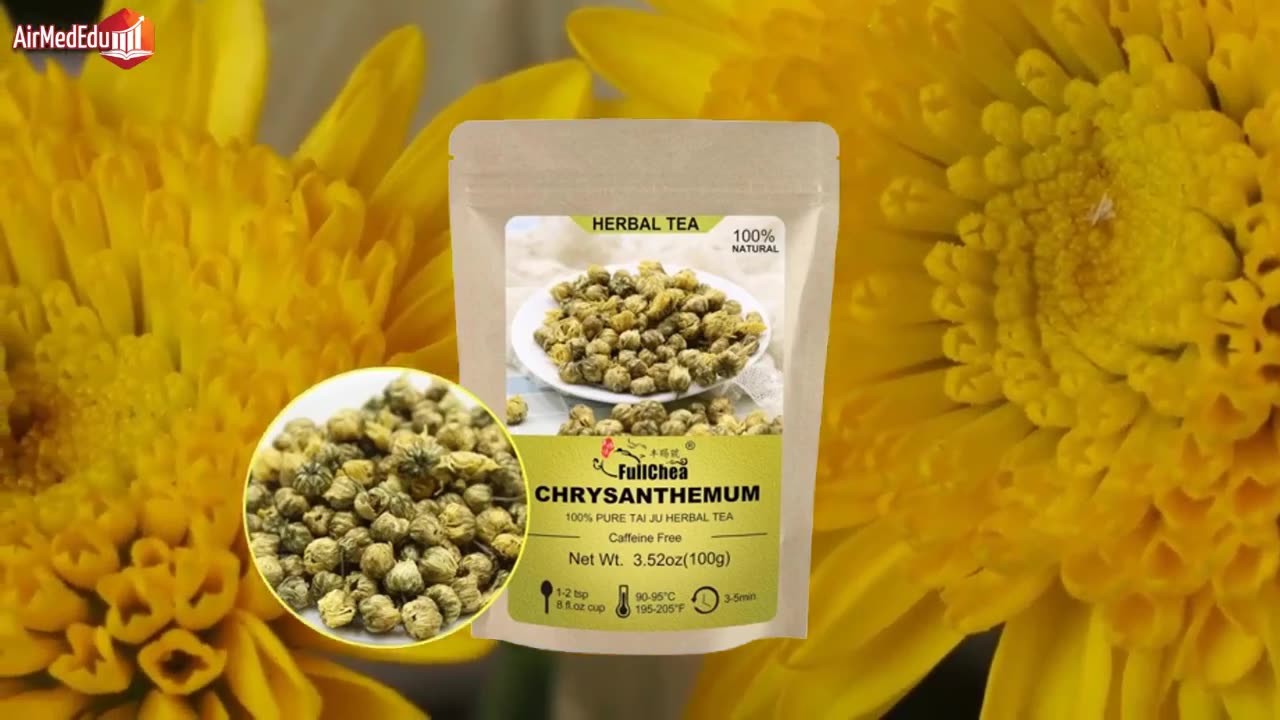Premium Only Content

Effects of Chrysanthemum Tea on the Body
Chrysanthemum tea, derived from the dried flowers of the Chrysanthemum morifolium or Chrysanthemum indicum plant, has been a staple in traditional Chinese medicine for centuries, where it is valued for its cooling and balancing properties. Native to East Asia, this floral infusion not only offers a subtly sweet and herbal flavor but is also consumed worldwide as a soothing beverage that promises health benefits. Prepared simply by steeping the flowers in hot water, chrysanthemum tea is commonly associated with relieving symptoms related to internal heat, according to the principles of traditional medicine, and its popularity has grown in the West thanks to its antioxidant profile. However, as with any herbal remedy, its effects on the body go beyond the therapeutic, encompassing potential unwanted reactions that require careful understanding. Below, we will explore the main impacts of this infusion on the human body, starting with its healing benefits and expanding to the less favorable aspects, all supported by limited but growing scientific evidence, to encourage informed and responsible consumption.
The primary therapeutic effects of chrysanthemum tea lie in its rich chemical composition, which includes flavonoids, phenolic acids, and polysaccharides, compounds that act as potent antioxidants. These elements help combat oxidative stress, a process that contributes to cellular aging and various chronic diseases. For example, regular consumption of this infusion may support cardiovascular health by promoting blood vessel dilation and reducing high blood pressure, making it useful in the management of mild hypertension. Preliminary studies suggest that its anti-inflammatory properties relieve conditions such as tension headaches and migraines by inhibiting the release of inflammatory mediators in the body. In traditional Chinese medicine, chrysanthemum tea is used to "clear heat" from the liver and eyes, which improves blurred vision or eye irritation caused by fatigue or prolonged screen time. Furthermore, its potassium content helps regulate electrolyte balance, potentially reducing the risk of stroke and supporting kidney function by promoting smooth diuresis.
Beyond these cardiovascular and ocular benefits, chrysanthemum tea exhibits antimicrobial and antiviral effects that make it a natural ally against minor infections. Laboratory research has shown that its extracts inhibit the growth of bacteria such as Staphylococcus aureus and certain viruses, including herpes simplex, which explains its traditional use to treat colds, fevers, and sore throats. In terms of digestive health, it can soothe an irritated stomach and relieve symptoms of indigestion, thanks to its compounds that modulate intestinal flora. For those seeking support with weight management or diabetes, its antioxidants help stabilize blood sugar levels by improving insulin sensitivity, although this requires further clinical studies to confirm. Overall, these primary effects make chrysanthemum tea an attractive option for daily wellness, especially in hot climates where its cooling nature helps combat heat fatigue and promotes an overall feeling of vitality.
However, while the therapeutic benefits are promising, it is essential to recognize that chrysanthemum tea, like any bioactive substance, can cause unwanted effects in the body. These adverse effects are commonly classified into categories based on their mechanism and predictability, a useful framework derived from pharmacology that helps understand how herbs interact with the human body. Starting with Type A, which are augmented or pharmacological, these arise from an exaggeration of the plant's normal effects and are dose-dependent, meaning they intensify with increased consumption. For example, since chrysanthemum tea has hypotensive properties, an excess could lead to an excessive drop in blood pressure, causing dizziness, fatigue, or even fainting in people with low blood pressure. Another example is its mild diuretic effect, which in high amounts could result in dehydration or electrolyte imbalances, manifesting as muscle cramps or weakness. These effects are predictable and usually resolve by reducing intake, but they underscore the importance of moderation, especially in individuals with preexisting conditions.
Moving on to type B effects, known as bizarre or idiosyncratic, these are unpredictable and not directly related to dose, depending largely on individual factors such as genetics or the immune system. Within this category, allergic subtypes are most common with chrysanthemum tea, as it belongs to the Asteraceae family, similar to ragweed or daisies. Sensitive individuals may experience allergic reactions such as rashes, itching, swelling, or contact dermatitis when handling the flowers or consuming the infusion. In more severe cases, it could trigger respiratory symptoms such as sneezing or difficulty breathing, although this is rare. On the other hand, idiosyncratic subtypes due to genetic variations involve differences in the metabolism of tea compounds; for example, certain mutations in liver enzymes could cause some individuals to process flavonoids inefficiently, leading to persistent nausea or heightened sensitivity without an obvious allergic cause. Although specific evidence for genetic variations in chrysanthemum is limited, studies on similar herbs suggest that polymorphisms in genes such as CYP450 may influence these atypical responses, making the effect "bizarre" in that it spares the majority but does affect a susceptible minority.
Type C, or chronic, adverse effects manifest with prolonged, long-term use, gradually accumulating in the body. In the case of chrysanthemum tea, chronic consumption could lead to increased photosensitivity, where the skin becomes more vulnerable to UV rays due to certain photosensitizing compounds in the flowers, resulting in more rapid sunburn or irregular pigmentation. Although not directly associated with tardive dyskinesia as with neuroleptics, a parallel could be the phenomenon of rebound inflammation: if used continuously to suppress inflammatory symptoms, discontinuation could temporarily exacerbate them. Furthermore, with extended use, there may be a subtle impact on liver function, as the liver processes tea metabolites, potentially leading to liver fatigue in individuals with excessive daily consumption for months or years. These chronic effects highlight the need for cycles of use, such as drinking the tea for limited periods and monitoring for any persistent changes in health.
Regarding type D, delayed, or long-latency effects, these emerge long after initial exposure and often involve reproductive or oncological risks. For chrysanthemum tea, although generally considered safe, there are precautions in pregnancy due to possible teratogenic effects; some compounds could interfere with fetal development if consumed in large quantities during the first trimester, although the evidence is anecdotal and there are no conclusive human studies. Regarding carcinogenicity, there is no evidence that it promotes cancer; in fact, its antioxidants may protect against it, but in rare cases of prolonged exposure to contaminated varieties, there may be a delayed risk if impurities are present. These effects are difficult to track, but they emphasize the importance of pure sources and avoiding consumption during critical life stages.
Type E effects, related to cessation of use or withdrawal, involve symptoms that appear upon discontinuing use after a prolonged period. Unlike addictive substances such as benzodiazepines, chrysanthemum tea does not produce a classic withdrawal syndrome, as it does not affect GABA or opioid receptors. However, in regular users who take it to regulate blood pressure or relieve stress, abrupt cessation may result in a rebound of symptoms, such as a temporary increase in tension or the return of headaches, similar to a bodily adaptation phenomenon. This is not common, but in contexts of chronic use for conditions such as heat-induced insomnia, there may be mild restlessness or irritability upon cessation, although these are mild and transient.
Finally, type F effects, or unexpected failures, arise from external factors such as impurities or contaminants in the product. Chrysanthemum tea, coming from cultivated flowers, may contain pesticide residues if not obtained from organic sources, leading to unpredictable toxic reactions such as nausea, vomiting, or even liver damage in extreme cases. Microbial contaminants or heavy metals from polluted soils could cause infections or accumulated toxicity, manifesting as chronic fatigue or neurological problems. These flaws underscore the importance of quality in herbal preparations, as they are not inherent to the pure chrysanthemum itself but rather to errors in the supply chain.
In addition to these classified adverse effects, it is crucial to consider the interactions of chrysanthemum tea with other medications, as its bioactive compounds can alter the pharmacokinetics of pharmaceutical substances. For example, it could potentiate the effect of anticoagulants such as warfarin, increasing the risk of bleeding due to its natural antiplatelet properties. Similarly, it interacts with statins used for cholesterol, possibly reducing their effectiveness or increasing muscular side effects. In patients on immunosuppressants, such as those post-transplant, the tea could stimulate the immune system, counteracting the medication and risking organ rejection. There are also reports of interactions with sedatives, where their calming effects are combined, leading to excessive drowsiness. These interactions are not universal, but require caution, especially in polypharmacy patients.
Regarding the toxic effects of overdose, although chrysanthemum tea is generally safe in moderate doses (one or two cups daily), excessive consumption can overload the body. Acute symptoms include gastrointestinal discomfort such as nausea, vomiting, diarrhea, or abdominal cramps, resulting from irritation of the stomach mucosa by its tannins. In severe overdoses, liver toxicity may occur, manifesting as jaundice or elevated liver enzymes, although this is rare and more associated with concentrated extracts than with infusions. Intensified allergic reactions, such as anaphylaxis, are possible in sensitive individuals, with symptoms such as facial swelling or respiratory distress requiring immediate medical attention. Toxicity also extends to pets, where it is highly toxic, but in humans, the threshold is high, and recovery is usually rapid with hydration and cessation of consumption.
On reflection, chrysanthemum tea offers a fascinating balance between tradition and modern science, providing therapeutic benefits that can enrich daily routines while carefully navigating its potential adverse effects. However, this exploration underscores that, although accessible and natural, it is not without risk, and its integration into personal health should be guided by knowledge and moderation. It's always wise to consult with health professionals, such as qualified physicians or herbalists, before incorporating it, especially if you have pre-existing conditions, are taking medication, or are in stages such as pregnancy. This way, you maximize its benefits while minimizing surprises, fostering a holistic and responsible approach to wellness.
-
 1:09:52
1:09:52
VapinGamers
3 hours ago $4.87 earnedTools of the Trade - EP11 Highs and Lows of Streaming with Gothix - !rumbot !music
10.7K2 -
 LIVE
LIVE
SOLTEKGG
4 hours agoARC RADIDERS "First Month-Anniversary on Rumble"
168 watching -
 2:14:09
2:14:09
LFA TV
21 hours agoRUMBLE RUNDOWN WEEK 6 with JEREMY HERRELL AND SHAWN FARASH 11.15.25 9AM
160K7 -
 1:44:16
1:44:16
HotZone
6 hours ago $4.81 earnedLive: The Hidden Crisis in US Special Ops: What They’re Not Telling You About Women in Combat
13K14 -
 53:25
53:25
Athlete & Artist Show
20 hours ago $1.38 earnedBombastic Bets & Games w/ Team Canada Veteran!
11.5K1 -
 53:13
53:13
X22 Report
5 hours agoMr & Mrs X - It All Revolves Around Marxism, Think Political Correctness, Midterms Are Safe - EP 16
74K19 -
 44:27
44:27
I_Came_With_Fire_Podcast
11 hours agoThe Right's Drift into Neo-Marxism & America's Populist Crossroads
12.7K7 -
 LIVE
LIVE
Amarok_X
4 hours ago🟢LIVE 24 HR STREAM? | ARC RAIDERS TO START | OPERATION 100 FOLLOWERS | USAF VET
32 watching -

Pepkilla
4 hours agoDay 2 of Camo Grinding Black Ops 7 ~ Until My Brain Rots
5.96K1 -
 27:34
27:34
marcushouse
6 hours ago $1.47 earnedWOW! I Was NOT Ready For This One… 🤯 | Starship & New Glenn Lead The Race!
4.65K2